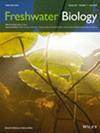Response of Pond Food Webs to Anthropogenic Habitat Degradation
IF 2.7
2区 生物学
Q2 ECOLOGY
引用次数: 0
Abstract
- In the context of the Anthropocene, it is crucial to understand how habitat degradation and species loss alter the structure and functioning of ecological communities. Using a pondscape within the Pampas Biome as a study model, we analysed the impact of agricultural intensification on the taxonomic and trophic assemblage of pond communities.
- We sampled ponds in landscapes of natural grasslands, artificial grasslands, and crop fields. Using a multitrophic approach that included zooplankton, macroinvertebrates, fish, and amphibians, we evaluated taxonomic richness, assemblage abundance, and food web structure. The trophic niche structure, energy pathways, and network topology were inferred from stable isotopes and stomach content.
- Ponds in crop fields exhibited lower species richness, with significant decreases in the abundance of tadpoles, fish, and predatory macroinvertebrates, and increases in scrapers and filter-feeding macroinvertebrates indicating a severe impact of agriculture. These ponds also showed more diversity in basal resources and trophic positions but reduced trophic redundancy. Although no changes in the relative importance of trophic pathways were detected, we observed fewer primary consumers subsidised by detritus in crop-affected systems. The ponds in artificial grassland exhibited fewer alterations than those in crop fields, where environmental disruption is greater.
- This study shows how land use impacts aquatic ecosystems, leading to loss of biodiversity and functional disruptions, and underscores the vulnerability of certain species and interactions to agricultural intensification.
- We highlight the urgent need for targeted management to mitigate these consequences for ecosystem resilience and services, safeguard biodiversity, and preserve ecosystem functions in agricultural landscapes.
池塘食物网对人为生境退化的响应
在人类世的背景下,了解栖息地退化和物种丧失如何改变生态群落的结构和功能是至关重要的。以潘帕斯湿地为研究对象,分析了农业集约化对池塘群落分类和营养组合的影响。我们在天然草地、人工草地和农田景观中取样池塘。采用包括浮游动物、大型无脊椎动物、鱼类和两栖动物在内的多营养方法,我们评估了分类丰富度、组合丰富度和食物网结构。根据稳定同位素和胃内容物推断出营养生态位结构、能量通路和网络拓扑结构。农田池塘的物种丰富度较低,蝌蚪、鱼类和掠食性大型无脊椎动物的丰度显著减少,而刮刀类和滤食性大型无脊椎动物的丰度增加,表明受农业影响严重。这些池塘在基础资源和营养位置上也表现出更多的多样性,但营养冗余度有所降低。虽然没有发现营养途径的相对重要性发生变化,但我们观察到,在受作物影响的系统中,由碎屑补贴的初级消费者减少了。人工草地的池塘变化比农田的池塘变化少,而农田对环境的破坏更大。该研究显示了土地利用如何影响水生生态系统,导致生物多样性丧失和功能破坏,并强调了某些物种及其相互作用对农业集约化的脆弱性。我们强调迫切需要有针对性的管理,以减轻这些对生态系统恢复力和服务的影响,保护生物多样性,并保护农业景观中的生态系统功能。
本文章由计算机程序翻译,如有差异,请以英文原文为准。
求助全文
约1分钟内获得全文
求助全文
来源期刊

Freshwater Biology
生物-海洋与淡水生物学
CiteScore
5.90
自引率
3.70%
发文量
162
审稿时长
2 months
期刊介绍:
Freshwater Biology publishes papers on all aspects of the ecology of inland waters, including rivers and lakes, ground waters, flood plains and other freshwater wetlands. We include studies of micro-organisms, algae, macrophytes, invertebrates, fish and other vertebrates, as well as those concerning whole systems and related physical and chemical aspects of the environment, provided that they have clear biological relevance.
Studies may focus at any level in the ecological hierarchy from physiological ecology and animal behaviour, through population dynamics and evolutionary genetics, to community interactions, biogeography and ecosystem functioning. They may also be at any scale: from microhabitat to landscape, and continental to global. Preference is given to research, whether meta-analytical, experimental, theoretical or descriptive, highlighting causal (ecological) mechanisms from which clearly stated hypotheses are derived. Manuscripts with an experimental or conceptual flavour are particularly welcome, as are those or which integrate laboratory and field work, and studies from less well researched areas of the world. Priority is given to submissions that are likely to interest a wide range of readers.
We encourage submission of papers well grounded in ecological theory that deal with issues related to the conservation and management of inland waters. Papers interpreting fundamental research in a way that makes clear its applied, strategic or socio-economic relevance are also welcome.
Review articles (FRESHWATER BIOLOGY REVIEWS) and discussion papers (OPINION) are also invited: these enable authors to publish high-quality material outside the constraints of standard research papers.
 求助内容:
求助内容: 应助结果提醒方式:
应助结果提醒方式:


